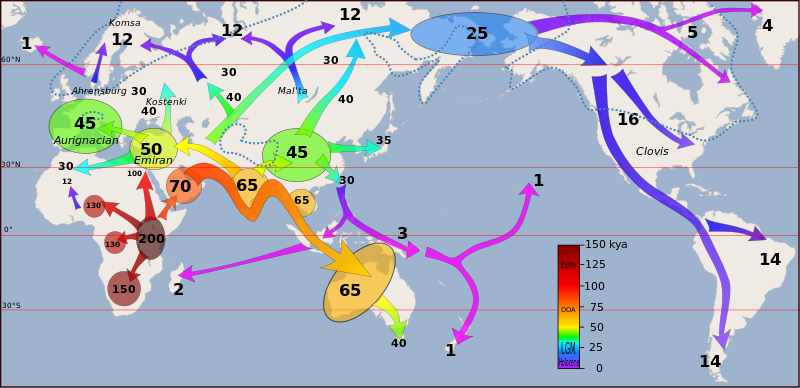tóng-àn:Early migrations mercator.svg

此 SVG 檔案的 PNG 預覽的大小:800 × 388 siōng-sò͘。 Kî-thaⁿ--ê kái-sek-tō͘: 320 × 155 siōng-sò͘ | 640 × 310 siōng-sò͘ | 1,024 × 497 siōng-sò͘ | 1,280 × 621 siōng-sò͘ | 2,560 × 1,242 siōng-sò͘ | 1,173 × 569 siōng-sò͘.
Choân kái-sek-tō͘ (SVG ùng-giông, chék-cháung: 1,173 × 569 chuông-só, ùng-giông duâi-nâung:392 KB)
Tóng-àn le̍k-sú
Chhi̍h ji̍t-kî/sî-kan, khoàⁿ hit sî-chūn--ê tóng-àn.
| Ji̍t-kî/Sî-kan | 細張圖 | 寸尺 | Iōng-chiá | Chù-kái | |
|---|---|---|---|---|---|
| hiān-chāi | 2023-nî 10-goe̍h 5-ji̍t (pài-sì) 06:11 |  | 1,173 × 569(392 KB) | Amortres | File uploaded using svgtranslate tool (https://svgtranslate.toolforge.org/). Added translation for ca. |
| 2018-nî 5-goe̍h 19-ji̍t (pài-la̍k) 08:07 |  | 1,173 × 569(394 KB) | Dbachmann | various improvements | |
| 2018-nî 5-goe̍h 12-ji̍t (pài-la̍k) 09:10 |  | 1,173 × 569(415 KB) | Dbachmann | updates / fixes | |
| 2018-nî 5-goe̍h 9-ji̍t (pài-saⁿ) 13:23 |  | 1,173 × 569(398 KB) | Dbachmann | ||
| 2018-nî 5-goe̍h 9-ji̍t (pài-saⁿ) 07:02 |  | 1,173 × 569(396 KB) | Dbachmann | ||
| 2018-nî 5-goe̍h 9-ji̍t (pài-saⁿ) 06:50 |  | 1,173 × 569(397 KB) | Dbachmann | {{Information |description ={{en|1=Peopling of the world (recent out of Africa and Upper Paleolithic) }} |source ={{own}} |author ={{own}} |date =2018 }} Category:Homo sapiens distribution maps Category:Out of Africa Category:Maps of the Upper Paleolithic |
Iáⁿ-siōng liân-kiat
Í-hā ê ia̍h liân kàu chit ê iáⁿ-siōng:
tóng-àn hō͘ lâng sái--ê chōng-hóng
Ē-kha--ê kî-thaⁿ wiki ēng tio̍h chit--ê tóng-àn:
- anp.wikipedia.org hō͘ lâng ēng--ê chêng-hêng
- ar.wikipedia.org hō͘ lâng ēng--ê chêng-hêng
- bn.wikipedia.org hō͘ lâng ēng--ê chêng-hêng
- ca.wikipedia.org hō͘ lâng ēng--ê chêng-hêng
- Paleolític superior
- Aurinyacià
- Història d'Europa
- Història de l'Argentina
- Cultura Clovis
- Història del Brasil
- Història de Xile
- Història d'Àfrica
- Pobles indígenes de l'Argentina
- Història precolombina de l'Argentina
- Emirà
- Migracions humanes prehistòriques
- Història genètica dels pobles indígenes d'Amèrica
- Ahrensburguià
- cy.wikipedia.org hō͘ lâng ēng--ê chêng-hêng
- de.wikipedia.org hō͘ lâng ēng--ê chêng-hêng
- en.wikipedia.org hō͘ lâng ēng--ê chêng-hêng
- eo.wikipedia.org hō͘ lâng ēng--ê chêng-hêng
- es.wikipedia.org hō͘ lâng ēng--ê chêng-hêng
- eu.wikipedia.org hō͘ lâng ēng--ê chêng-hêng
- fa.wikipedia.org hō͘ lâng ēng--ê chêng-hêng
- fi.wikipedia.org hō͘ lâng ēng--ê chêng-hêng
- fr.wikipedia.org hō͘ lâng ēng--ê chêng-hêng
- fy.wikipedia.org hō͘ lâng ēng--ê chêng-hêng
- hy.wikipedia.org hō͘ lâng ēng--ê chêng-hêng
- id.wikipedia.org hō͘ lâng ēng--ê chêng-hêng
- ja.wikipedia.org hō͘ lâng ēng--ê chêng-hêng
- ko.wikipedia.org hō͘ lâng ēng--ê chêng-hêng
- ku.wikipedia.org hō͘ lâng ēng--ê chêng-hêng
- nl.wikipedia.org hō͘ lâng ēng--ê chêng-hêng
檢視此檔案的更多全域使用狀況。















